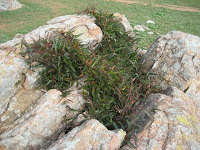Welcome to the sixth edition of ‘Ochre Archives’.
Feedback on Ochre Archives No. 5
Sue Hudson, Indigenous Archaeological Consultant, let us know that “both Sida corrugata and Hopbush were used by Aboriginal people as bush-tucker. The roots of Sida were used as a vegetable (roasted in ground-oven like parsnip) and the seeds from around ant nests were collected, ground and turned into flour-like consistency for cakes. With Hopbush (D. boranifolia, D peducularis and D. truncatatiales) the fruit was dried (easier to carry) and reconstituted in water and either eaten or used for flavouring as a drink.”
Alanna Moore from Geomantica suggests that “you can also try adding crushed basalt to algified waters or organic barley straw-bales around where water runs in (could be expensive!). With Matt Rush, the base of the leaf, was chewed as an important carbohydrate source in the Aboriginal diet plus they were woven into articles. A most useful plant!"
An organic farmer has let us know that de-stocking only damages the land in brittle environments [as per Savory] where it is for an extremely long period. Peter Braden wanted to understand the underlying causes of how this can occur where native animals are still in the environment. The answer is quite involved. It’s probably best that I refer readers to the book titled Holistic Management – A New Framework for Decision Making by Allan Savory. Peter also asked whether Biodynamic preparations are effective in the home garden. In short - most definitely - based on our own experience.
Jacqui Stol from the Agricultural Landscapes Research Group within CSIRO Sustainable Ecosystems noticed the photo of one of the white fungi in the newsletter and a couple of days later was shown a similar photo by one of the CSIRO researchers, Sonia Graham. Jacqui referred the photo to her mycologist friend Professor Jim Trappe, from Oregon State University who responded “the fungus is a slime mould, Fuligo septica. Its common name is the ‘Dog Vomit Fungus’. At early stages it is soft and slimy, later it dries out and forms a mass of dark spores. It is closer phylogenetically to animals then to plants, and the mass when soft moves slowly across the substrate, engulfing organic matter and stuff to digest like an amoeba, except it is multicellular. A weird but cool organism”! We fully concur with Jacqui’s closing comment - “What a fascinating thing - being closer to the animal kingdom than the plant kingdom”. A Google search brought to light an article on slime moulds by a bloke by the name of Tom Volk. Curiously he mentions that it was slime moulds that inspired the science fiction movie, "The Blob." (1958 with Steve McQueen, remade in 1988).
Findings from recent trips to the farm
Trees and Shrubs

We’ve now found 2 native False Sarsaparilla (Hardenbergia violacea) plants growing on Ochre Arch. They are leguminous and don’t like frosts.
Insects
During a 30 mm rainfall event in May we had some Giant Swift Moths (Trictena Argentata) flying into the glass on the front door of the house on the farm. They are also known as Rain Moths because of their habit of emerging from the cocoon (brown pupal shells) in the earth following late autumn rains.

To quote from the South Australia Museum website: "Waikerie" on the river Murray bears the Aboriginal name for this moth whose emergence in great numbers at this place provided a seasonal feast for the Aborigines” and that the “grubs feed on bark of gum trees.” The Waikerie website explains that the Aborigines “dug them from the ground or caught the emerged moth as they flew around their camp fires at night”.
Birds
We now regularly see a pair of Wedge-tail Eagles.

During the June long weekend we watched this solitary Glossy Black Cockatoo blissfully crunching its way through a mass of seedpods on two of the She-oak trees on the farm. We’d never seen these before, and now know they are listed as ‘vulnerable’ on the Department of Environment and Climate Change NSW Threatened Species database.

Erosion control
We are reducing soil erosion risk and activity through encouraging increased organic matter ground cover (addressing the root cause - bare ground) and taking steps to slow the speed of water runoff where it’s practical to do so. Organic matter ground cover is being increased through (continuing to keep stock off the place) allowing the grass to grow and physically placing organic matter on bare ground. On some of the tracks we have been strategically placing a shovel full or two of grass with soil in the (mini) emerging gullies (for want of a better term) to slow the water down during rainfall events. You can see in this photograph how effective this can be. What is also obvious from the photograph is just how much soil is being washed, and how some of it is being trapped and retained.

We have quite a few smaller trees growing through some of the fences. Rather than have them further damage the fences as they grow we are removing them and placing the organic matter on the larger patches of bare earth. Positive results are apparent after as little as 3 weeks, evident through the backing up of soil against the on-ground branches, growth of grass adjacent to the organic matter, and reduced rate of soil loss. There’s still a huge way to go.
Tips and Hints
Our thanks go to Wayne Lavers and Mikla Lewis for sharing with us what we think is a fabulous tip when planting trees and shrubs. Rather than buying special guards and protectors just place some thick fallen branches over the seedlings. The branches keep native herbivores such as Kangaroos away, provides protection for the plant and habitat for small critters, and avoids the need to outlay $’s for the guards.
In Closing
Once again, feedback is most welcome, via email to pdiprose@optusnet.com.au.
Kind regards… Phillip & Jan Diprose
Link to Ochre Archives Newsletter - Issue No. 5
